A motorcycle with a flat tire is a major problem since motorcycles don’t come with a spare tire as cars do. This makes a flat tire a serious problem for any biker, especially if you are on a long trip on a quiet road. What can bikers do when they have a flat tire to get themselves out of this jam? Can you use the “Fix A Flat” product on motorcycle tires?
“Fix A Flat” is not a recommended product to use on motorcycle tires. The manufacturer discourages using the product on motorcycles. If this product is used, you should ride very slowly to the next tire repair shop to professionally repair the puncture.
Cars have the advantage of having 4-wheels in contact with the road, while motorcycles with only two wheels on the ground are affected badly by an imbalance in one of the tires. This is a concern many motorcyclists have about introducing products into the tire to fix the puncture and get back on the road.
Is it safe to use products like Fix A Flat on motorcycle tires?
Getting a puncture on your motorcycle tire is a major dilemma for the rider, especially with no spare tire in the trunk! The problem is compounded if you have no mobile phone reception in the area or are on a quiet stretch of highway with no help in sight!
In situations such as this, it would be useful to be self-sufficient and have the necessary equipment to get yourself out of the jam without someone to help you. Even a temporary fix that allows you to limp to the nearest town or tire repair shop is better than being stuck on the side of the road for hours on end!
This is where products such as “Fix A Flat” can be an invaluable self-rescue tool to get you on the road again towards civilization and safety. However, the problem is that many tire sealant products are not recommended for high-performance motorcycles and can be dangerous when used on these tires.
“Fix A Flat” is a conveniently sized product, and its compact and lightweight package may tempt riders to take this product along as an emergency solution on the road. However, it should not be your primary tire repair solution.
The manufacturer of “Fix A Flat” recommends against using the product on motorcycles.
A better solution is to carry a tire plug repair kit and a CO2 tire inflation kit to get the repaired tire up to pressure. Some bikers carry “Fix A Flat” as an additional measure and will use it in an emergency despite the manufacturer’s warning against this practice.
“Fix A Flat” is an aerosol can about the size of most insecticide tins, with a pipe protruding from the actuator button that can be connected to any standard tire valve.
It is packaged as an aerosol can with a pressurized sealant inside that will seal the puncture and inflate the tire simultaneously.
Many bikers like to carry products like “Fix A Flat” because of its compact size, convenience, and speed with which this solution can be deployed. You can have your flat tire repaired and be back on the road in 30-minutes or less with this product without the need for any tools.
You can have your flat tire repaired and be back on the road in 30-minutes or less with this product without the need for any tools.
It should be noted that this is not a permanent fix for the puncture in the tire. The product is only rated to last 3-days or a maximum of 100-miles. The “Fix A Flat” aerosol is not intended as a permanent fix but rather a temporary, emergency fix to get you to your nearest tire repair shop.
The product comes in a variety of can sizes designed to be used on specific tire sizes. This will ensure you have a can that can properly inflate the tire to the point that it is safe to ride without causing damage to the tire or the wheel rim.
The product supplier has a tire size calculator to establish the correct size “Fix A Flat” can you need for your tire size. Input your tire size, including the rim size, into the calculator, and it will calculate the optimal size can you need for your tire.
Motorcycle tires and their conditions are an important safety aspect for bikers, and anything that can affect the balance or weight distribution in the tire can be dangerous. This is especially true on performance motorcycles capable of high speeds, where the tire’s condition is even more important for riding safety.
This is especially true on performance motorcycles capable of high speeds, where the tire’s condition is even more important for riding safety.
The sealant injected into the tire can settle unevenly inside the tire, throwing the tire’s balance off because of the uneven weight distribution of the sealant in the tire.
This can have dangerous consequences to the tire’s stability, especially at speed, and can produce unpredictable performance anomalies to the bike and its road holding capability.
Another safety aspect to bear in mind is that the product may not inflate your motorcycle tire to optimal pressures. Improper tire pressure, either over or under-inflated, can have serious repercussions on the performance of the bike and the tire’s ability to perform on the road surface.
If you have used this product in your motorcycle tire, you should exercise extra care when riding your bike after injecting the product to fix a puncture. Keep your speed low and don’t ride aggressively since the bike’s handling and performance may be compromised with less-than-ideal tire pressure and tire imbalance.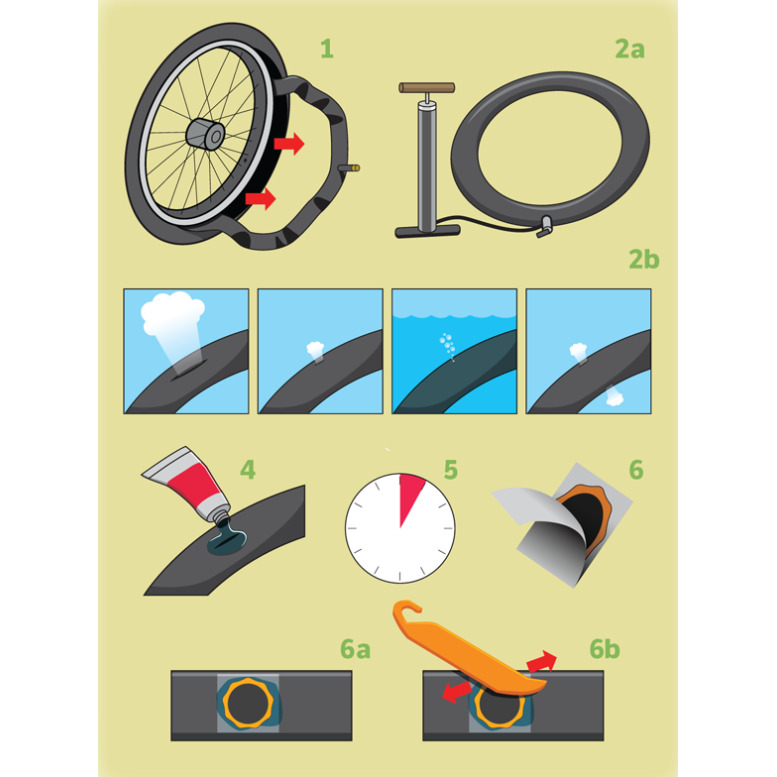
There are some alternative tire products you can use on a motorcycle to repair or prevent punctures to avoid being stranded on the side of the road.
Some products are a sealant you put in the tire as a preventative measure to protect the tire from minor punctures. These products are a tire treatment that is installed in the tire and evenly distributed to provide an extra layer of sealant along with the inside crown of the tire where the tread is located.
This layer of sealant prevents items from piercing into the tire far enough to cause a leak, and if they do, once the item is removed, the sealant self-heals to close the hole.
An example of such a product is Ride-On Tire Protection, which can be installed by a tire shop, or a DIY installation but requires access to a compressor to inflate your tire.
According to the manufacturer, “Fix A Flat” should not be used as a puncture repair solution for motorcycles. However, many riders still carry and use this product as an emergency measure.
However, many riders still carry and use this product as an emergency measure.
If you are a rider that does this, it requires extreme caution riding the bike after administering the product, and you should get to a tire repair center as soon as possible to have the sealant removed and the puncture repaired professionally, and the wheel balanced.
A safer alternative to “Fix A Flat” is to carry a puncture plug repair kit with a CO2 inflation kit. This may take a little longer to repair the puncture, but you can ride in safety after the puncture repair.
Regardless of your motorcycle experience level, flat tires suck.
I mean, even in a car, they still are crap-tastic.
They just always happen at an inconvenient time. That makes sense, I guess. No one walks outside into the sunshine, stares at a shiny two-wheeled toy and says, “Well, I guess I wouldn’t really mind a flat today!” That inevitable event does suck a lot less, though, if you know how to do some basic tire repair.
Pesky little bugger. RevZilla photo.A reader sent us a kite and asked us to demonstrate how to repair a tire on the road, so Spurgie got out his camera and I cut up a tire so we could walk you through the simple process of plugging a hole in a tubeless motorcycle tire. This ain’t a guide for breakin’ down tires in a shop for a proper patch-plug or replacement tire, though. This is the quick and dirty info on how to plug a tubeless tire to get you to your garage or the shop down the road. It's a temporary repair. Treat it as such!
Before you do anything… don’t even think of using Fix-a-Flat. It doesn’t work reliably at all, it makes a huge mess, ruins balance jobs, and generally pisses off any tech (or you) who has to deal with it to make a permanent repair or replacement. As a professional wrenchy guy, let me tell you a secret: We charge you extra. Why? Because we have to sit there in work duds redolent of tire goop while we eat lunch. Oh yes, you’ll pay. Instead, purchase a tire repair kit. Ideally, do this before you have that flat.
Ideally, do this before you have that flat.
Allow me to pontificate further, if you will. More expensive flat kits are often a good value. I’m doing this writeup with your garden-variety cheap-o kit you can get at the auto parts store. It’s inexpensive, but nearly any other option is better. The cheap kits may get the job done, but they rarely include any way to put air back in the tire after the repair is performed. Having a way to reinflate the tire is a primo idea. Yes, it increases the cost of the kit, but it also means you can air up easily when you break down in East Jabip.
Make sure you get a kit with T-handle tools, not the straight screwdriver kind. Saving (literally) a buck or two on the straight-handled ones seems like a great idea until you stab yourself with a reamer in the middle of a cornfield in Indiana somewhere. The better kits, especially motorcycle-specific ones, may also have mushroom-shaped plugs that are more likely to seal the hole than the plain strings.
Here's the bare minimum of what you'll need to plug a tire with a hole in it. From left to right are string-style plugs, a reaming tool, and the plug insertion tool. RevZilla photo.
You should figure this out before you’re standing beside the road with a flat. Repairing (plugging) tubeless tires is easy and fun. Well, it’s easy, anyway. How do you know if you have a tubeless tire? Well, most cast wheels use tubeless tires, and most spoked wheels use tubes. Of course, there are exceptions. Some Japanese, H-D, and Italian bikes from the late 1970s and early 1980s come to mind as bikes that used cast wheels and tubes. And there are some modern ADV bikes (KTMs and BMWs, among others) that have spoked wheels that utilize tubeless tires.
If you’ve got a tube-type tire, repair is going to involve either replacing or patching your tube. This is no different than doing the job in the shop, only you’ll have a more difficult time getting the wheel off. If you know how to replace a tube, do so at this time, and if you don’t, call for a transport vehicle. Protip: Lay the bike down for a little nap so you can pull the wheel off. The unfortunate truth is that catching a flat with tubes is inconvenient on the road and there are no shortcuts.
If you know how to replace a tube, do so at this time, and if you don’t, call for a transport vehicle. Protip: Lay the bike down for a little nap so you can pull the wheel off. The unfortunate truth is that catching a flat with tubes is inconvenient on the road and there are no shortcuts.
If you do have tubeless tires, congratulations! Now proceed to the next step.
After you find the offending item, mark the tire so you can see the hole after it is removed. See those lines I drew off to the sides? That's about the outer limit of what should be repaired. Plugs placed outside those boundaries are subject to a fair amount of flex and heat, neither of which is conducive to keeping the plug in place. RevZilla photo.
That air is coming out somewhere, right? Most of the time, the valve stem and bead aren’t the offending items. Normally, there’s a hole somewhere. If you can hear or see the hole, great! If not, you gotta find it. Roll the bike around a little bit if you have large fenders and can’t see much of the tire. Soapy water can help here if the leak is a slow one — the leaking air will blow bubbles. This is best done from a spray bottle, but I have definitely mixed up gas station bathroom soap and water in a Gatorade bottle before.
Roll the bike around a little bit if you have large fenders and can’t see much of the tire. Soapy water can help here if the leak is a slow one — the leaking air will blow bubbles. This is best done from a spray bottle, but I have definitely mixed up gas station bathroom soap and water in a Gatorade bottle before.
Don’t plug a tire in the sidewall or even near the “corner” of the tread where it meets the sidewall. That rubber flexes quite a bit, which makes tire plugs sad. If you decide to ignore that advice, ride slowly. Motorcycle tire blowouts ain’t that hot.
Step Three is the easiest step, because it requires you not to do something. Don't yank out that damn drywall screw or whatever it is just yet, especially if you don’t have a reinflation method handy. Resist the urge. #donttouchityet
Before you go pulling out the item which has breached your tire, get set up first — especially if you don't have an air source, but have some air left in the tire. Here, the string plug is installed in the insertion tool. Note the split section at the tip of the tool. That split allows the tool to be removed while the plug remains in place. RevZilla photo.
Here, the string plug is installed in the insertion tool. Note the split section at the tip of the tool. That split allows the tool to be removed while the plug remains in place. RevZilla photo.
Assemble your plug. It needs to go through the eyelet in the tool, just like threading a needle. You kinda gotta squish the end to get it in there. I may or may not use my teeth to pull it halfway through the eyelet. I don’t use the cement that comes in those little kits, because usually it sits in my tool roll until I need it, when it is hard as a rock and I throw it away. If yours hasn't turned to stone and you feel like you’d like to use it, slather that puppy up now.
Note that the reaming tool has a deeply knurled surface along its shaft. That knurling helps to clear the hole of debris and strands of tire belt, preparing it to receive the plug and make an airtight seal. RevZilla photo.
OK, this is the part where you wanna work fast if you have no air and you’re gonna try and nurse this bike up the road to the filling station with the nine-dollar air machine.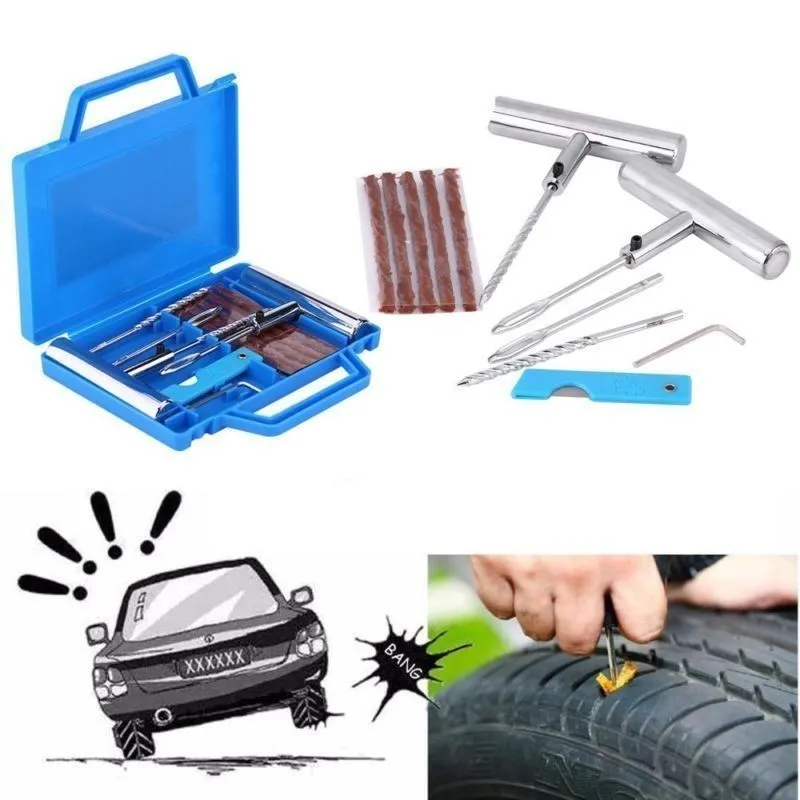 Use pliers or a Leatherman to yank that nail/screw/staple/whatever. If you’re really lucky, it didn’t puncture the liner. You can have a hearty belly laugh, put away your tire plugs, and ride off into the sunset. Since you won't be that lucky, you’ll hear a big hiss of air. At this point, jam that reamer into the hole. (That’s the poke-y lookin’ thing with the knurling on the shaft.) A couple of quick strokes in and out will rough up the rubber to accept the plug, and size the hole correctly for the plug. It also helps to dull any burrs that may have cropped up on the steel belts.
Use pliers or a Leatherman to yank that nail/screw/staple/whatever. If you’re really lucky, it didn’t puncture the liner. You can have a hearty belly laugh, put away your tire plugs, and ride off into the sunset. Since you won't be that lucky, you’ll hear a big hiss of air. At this point, jam that reamer into the hole. (That’s the poke-y lookin’ thing with the knurling on the shaft.) A couple of quick strokes in and out will rough up the rubber to accept the plug, and size the hole correctly for the plug. It also helps to dull any burrs that may have cropped up on the steel belts.
It should be noted at this point that you need to eyeball the hole. If it’s bigger than a quarter of an inch or so, plugging is not recommended. Have I ever doubled up and jammed two plugs in a tire to get down the road? Of course. Should you do it? Probably not.
If you had X-ray vision (or a Lemmy-modified tire), this is what your repair would look like from the inside as you performed it.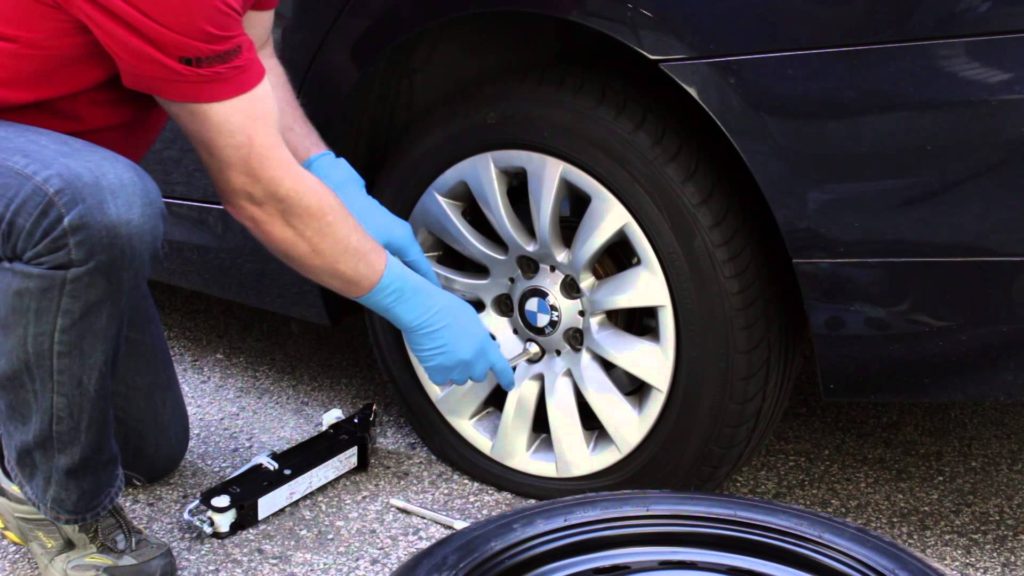 The insertion tool locates the plug at whatever depth you choose, and then the tool is backed straight out, leaving the plug in place. RevZilla photo.
The insertion tool locates the plug at whatever depth you choose, and then the tool is backed straight out, leaving the plug in place. RevZilla photo.
OK… we’re still moving quickly here, unless you’re one of those responsible types who carries an inflation tool of some flavor in the toolbag. As you finish up your reaming, pop the reamer out and quickly jam that plugging tool in the now-smooth void. Push push push until you have about a half an inch of each of the “tails” hanging out. Then yank the tool out. The tension of the rubber will hold the plug in place while the tool releases because of that small slit in the end.
Next, nip the exposed ends of the plug off flush with the tire's surface. This will help keep the road from "grabbing" the sticky plug and tugging it out. RevZilla photo.
Trim the ends of the plug flush with the tread so the road doesn’t rip out the fruits of your labor. Wiggle it around a little bit, see if you can feel or hear air leaking past. If you followed that advice about not plugging a hole bigger than a quarter of an inch, it should be airtight.
Wiggle it around a little bit, see if you can feel or hear air leaking past. If you followed that advice about not plugging a hole bigger than a quarter of an inch, it should be airtight.
It's really hard to detect a leak and finish the plugging process while keeping enough air in the tire to ride it to someplace where you can inflate it. That's why it's wise to carry some source of air with you, whether it's a hand pump, an electric pump or compressed CO2 cartridges. If you have any of those, inflate the tire to proper pressure. If you have no air and and there's still a few pounds of pressure in there, ride slowly to the nearest area with some air and air up.
Now that we’re through the process, let me be a buzzkill: This is a temporary fix. Your tire is damaged, and even with a patch-plug (the best way to repair a damaged tire), most tire manufacturers say with a repaired tire, all bets are off. Your tire “loses” its speed rating. Additionally, the steel cords are now exposed to road debris, salt, and moisture. You really don’t want to have a belt separate on a motorcycle tire.
You really don’t want to have a belt separate on a motorcycle tire.
That's why your final step is to fit a new tire. I shouldn’t have to tell you my preferred source for low-cost, high-quality rubber.
A punctured tire is still a pain in the ass, but having the tools and know-how to make a temporary repair can save you from spending hours by the road waiting for your buddy to get there with his truck or your roadside assistance plan to scare up a flatbed.
There is not always a way to call a tow truck, and driving on a flat tire, “chewing” the rubber and killing the rim is at least uncomfortable.
The very first replacement of rubber on a motorcycle or scooter gives reason to think - what is better in terms of quick repairs: tubeless ones that do not require wheel disassembly to eliminate a puncture, but leave the rider helpless if, along with damage, it “led” and flattened the edge of the disc? Or chambers - allowing sealing almost ring breaks (if only there were enough patches), but requiring the removal of rubber from the rim for this? The unequivocal answer is no. Few classics, straights or tourers today remain "loyal" to tube rubber models: tubeless tires are lighter, softer, warm up and cool down faster thanks to simplified heat transfer. In sports, more precisely - enduro and motocross, chamber - on the contrary, prevail: only spoked wheels can "play", withstanding strong alternating loads during landings and impacts.
Few classics, straights or tourers today remain "loyal" to tube rubber models: tubeless tires are lighter, softer, warm up and cool down faster thanks to simplified heat transfer. In sports, more precisely - enduro and motocross, chamber - on the contrary, prevail: only spoked wheels can "play", withstanding strong alternating loads during landings and impacts.
The nuance is that a tire with a chamber can be put on any spoked or cast disc, and a tubeless one can only be placed on a cast one, because only it can ensure tightness. Tube – can be installed in a tubeless tire as an emergency measure. In case of major damage to the sidewall, cracks or curvature of the edges of the rim, this will make it possible, after pumping up the wheel, to reach the nearest tire service (and there already - straightening, balancing and other maintenance according to the rules). True, for such a focus, it is advisable to take a camera with a face value one less than the diameter of the disk, otherwise it will create folds inside that will rub for a couple of hundred kilometers.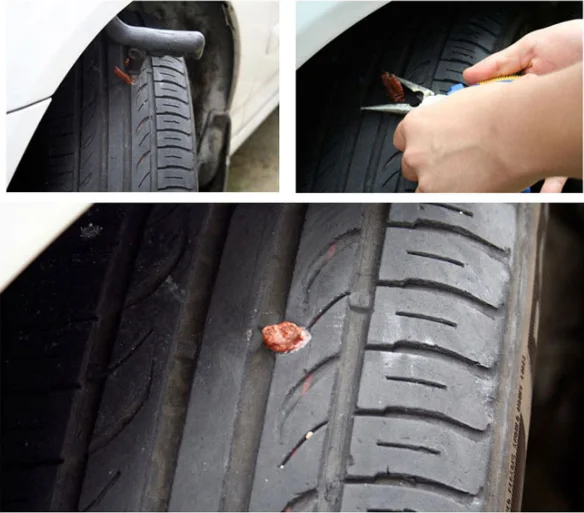 The resource of such a “treatment” is large - until the next puncture, like a new one.
The resource of such a “treatment” is large - until the next puncture, like a new one.
It depends on the magnitude of the damage whether it will be possible to eliminate it on your own, or whether you will have to “surrender” to the motorized tow truck. In tubeless - holes up to 5–6 mm are patched, in chambers - as much as there is enough glue and patches, the main thing is the condition of the tire. To determine the extent of the disaster - find a place where you can safely stop without violating traffic rules (where it is prohibited - you will have to sacrifice tires and drive on).
If the wheel deflates slowly, and the object that pierced it is still inside, you can try to carefully drive to the tire shop. A completely deflated "pancake" will have to be resuscitated on the spot, or - remove the wheel and take it to the service.
To find a hole in a tubeless tire, if it is very thin and not immediately visible, the wheel must be pumped up, slowly pouring water - bubbles will go.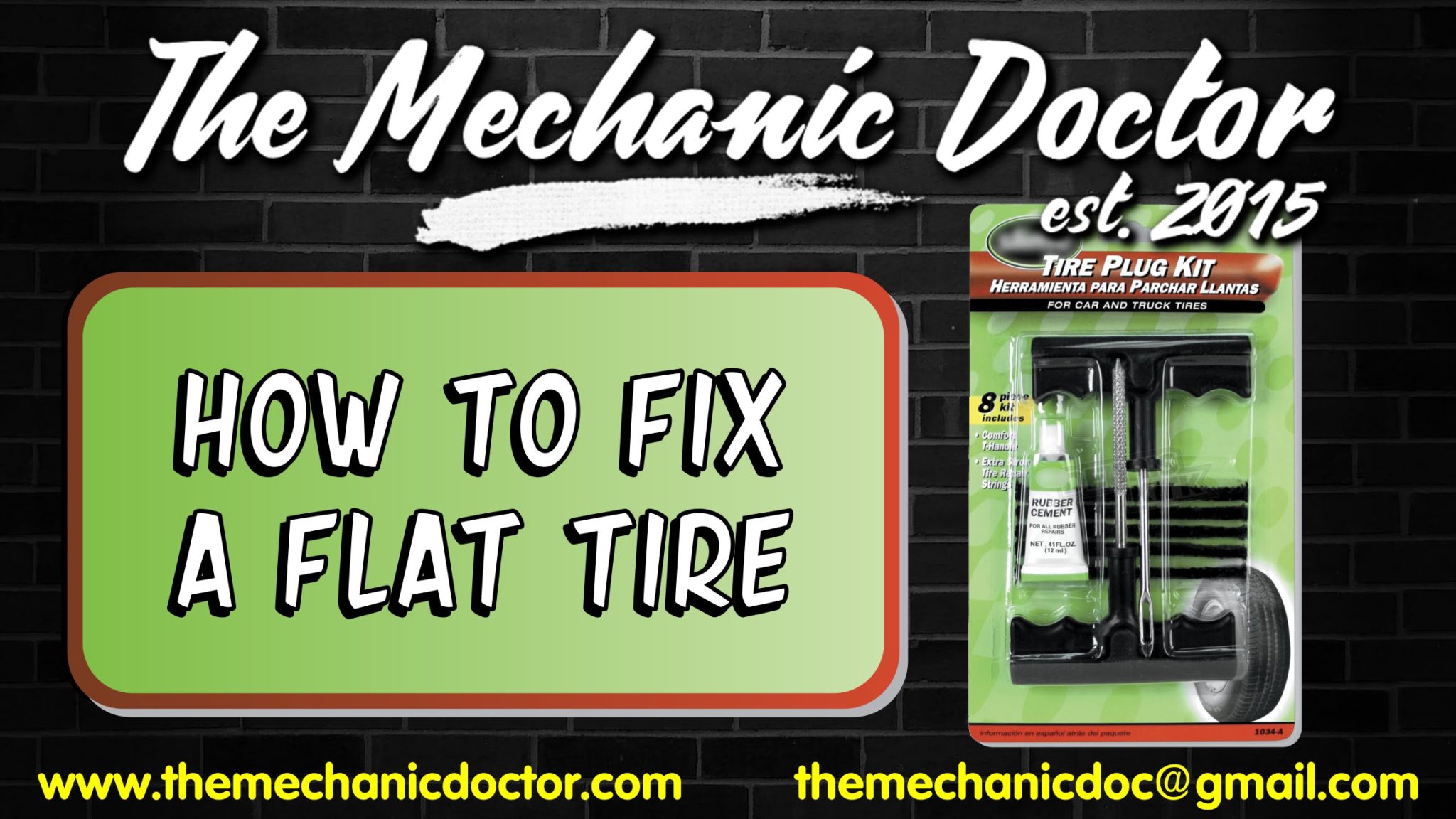 In place, tubeless tubes can be “harnessed”, or filled with sealant inside, without removing from the motorcycle.
In place, tubeless tubes can be “harnessed”, or filled with sealant inside, without removing from the motorcycle.
With the second type of tires - more difficult. A torn balloon must be removed from the tire to detect a defect and seal. In a good way, the wheel must be removed from the motorcycle and disassembled on a clean, flat, hard base. Suppose such a “patch” can be provided even off-road, but how to remove the wheel on a motorcycle if it does not have a central stand? And shooting is not required. The motor must be carefully laid on its side, after making sure that the faucet is closed, gasoline does not flow out through the tank cap (antifreeze does not flow from the tank if the motor is “dropsy”), and removing the plastic or wardrobe trunk with fragile contents (if any).
You will have to unscrew the wheel from the motorcycle only if you need to replace the tire, or it is decided to patch the tubeless tube with a “fungus”. In the absence of a central stand, this will also have to be done on a lying bike, or - make this stand from improvised materials (bricks, stump, car jack), placing them under the crankcase protection from below, the central tube of the frame, the duplex jumper (but not under the plastic, itself engine crankcase or attachments!), under both footrests - if they are not folding, or - under the pendulum.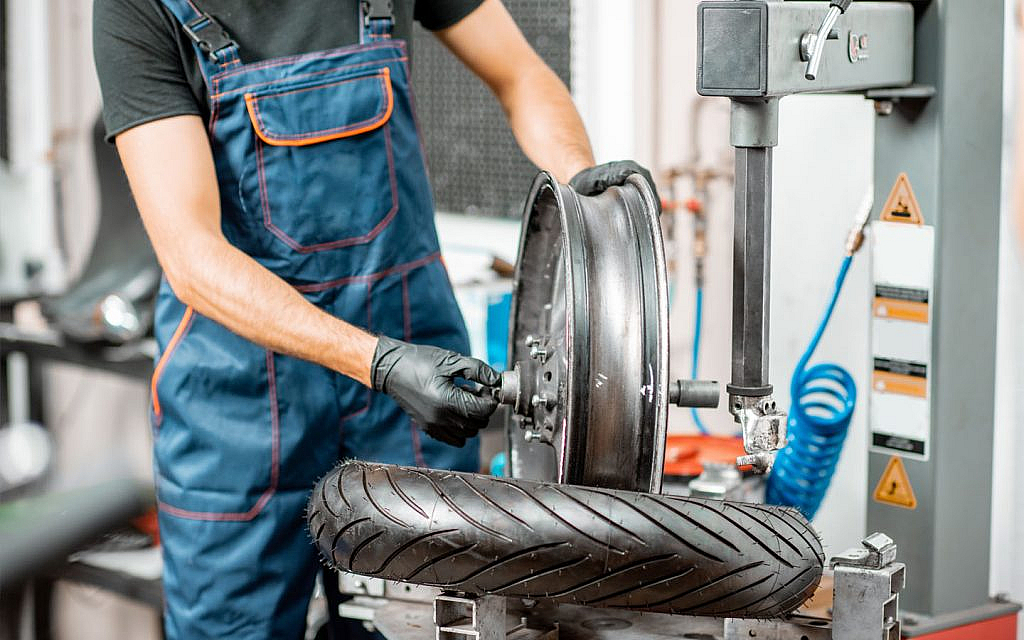 Before removing the rear wheel on a motorcycle, the front fork must be loaded with something, or an even higher lining is made.
Before removing the rear wheel on a motorcycle, the front fork must be loaded with something, or an even higher lining is made.
In a motorcycle tire fitting shop, tubeless tubes are repaired by cold vulcanization. They are removed, disassembled, the puncture site is cleaned from the inside, degreased, lubricated with glue and a calibrated “fungus” patch is inserted into the hole from the inside. The fungus itself is a thin plate of rubber with a “leg” tube in the center. The leg - by the guide wire is dragged through the hole of the damage, and the "hat" seals it.
After half an hour - you can put the tire back. The reliability of such a repair is high, the patch does not cause a significant imbalance, the service life of a sealed tire does not decrease.
This method is also applicable on the road, the main thing is to have the necessary equipment and materials with you:
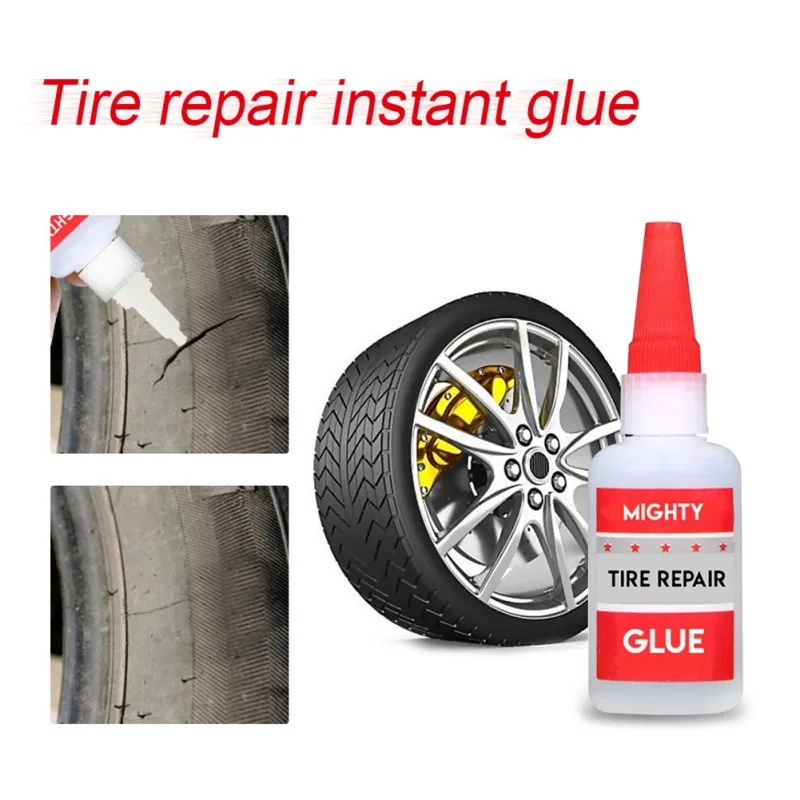
The fungus repair procedure does not require much experience. The main thing is to keep it clean, fully clean the place where the patch fits, let the glue dry slightly to a dull finish and press (roll) the surface of the fungus with high quality, expelling all the air between the layers. If necessary, you can degrease the place before gluing with gasoline, but without the rest of the above, it will not be possible to fully carry out repairs.
The compressor is sometimes replaced by a small cylinder of compressed air or carbon dioxide. Unlike a mechanical pump, it will immediately create a “throw” of pressure, pressing the tire beads against the rim flanges (in emergency cases, even a fire extinguisher was used to pump flat tubeless wheels). When connecting the compressor, start the bike's engine before you start inflating the tire - let it idle.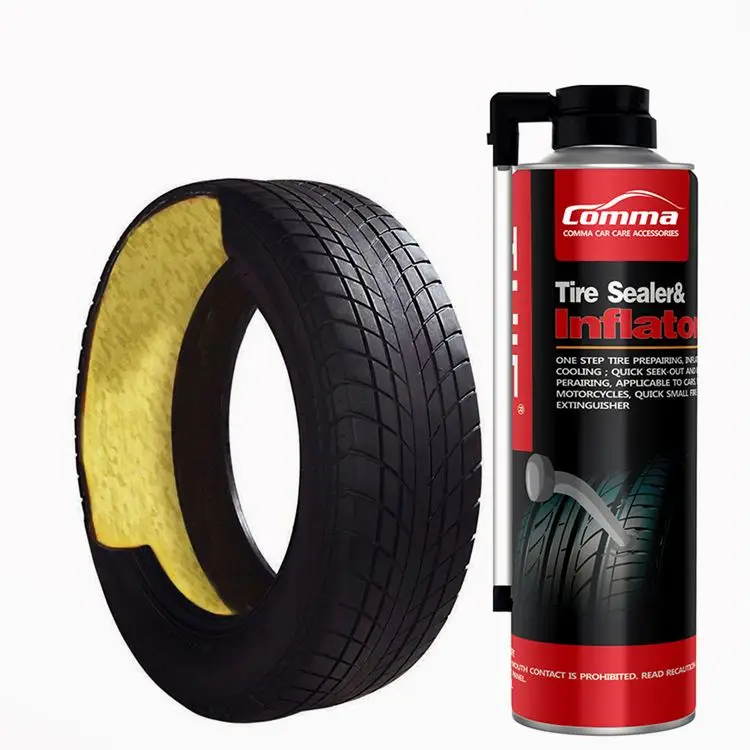 Otherwise, the motor can "land" the battery, and you will not start.
Otherwise, the motor can "land" the battery, and you will not start.
Manometer - needed for control. It is undesirable to pump over the repaired tire. It is recommended to "inflate" 0.2 atmospheres less than the nominal value. Inflating too little is also bad: a flat tire has a larger contact patch with the road, so the place of a fresh patch will deform more.
“Burning” a tubeless tube and sealing its internal cavity through a nipple are quick, simple methods that do not require special skills. To repair the damage, you only need the materials themselves, and how to pump up the wheel.
Now in Moscow, and not only, 6-5 varieties of cans with a sealant are sold - a quickly hardening "liquid rubber", with a volume of 800 to 250 ml.
Applying "Anti-Puncture" is simple: put a tube with a fitting on the nipple of the camera, turn the can over, and hold the button according to the instructions. Then - pump up the wheel, cleaning the nipple from the foam, roll it, making a full turn to distribute it.
Then - pump up the wheel, cleaning the nipple from the foam, roll it, making a full turn to distribute it.
The sealant is blown out with air into the puncture hole and clogs it, solidifying. After 20 minutes - you can go. Reliability of repair is high. Resource - until the next puncture.
If you have a compressor, start immediately pumping up the wheel, so it will be easier to work with a puncture, insert a patch, and it will swell faster.
Procedure:

You can go in 5 minutes, you just need to make sure that it doesn’t descend anywhere else.
Outwardly identical, repair kits for harnessing wheels can differ in price by almost half. This variation is explained by different configurations - one will have only three items, the other - six or seven.
A complete tubeless tire repair kit contains:
Regardless of the cost, you need to choose a kit in which the harnesses will be reinforced, and the awl - with a deep spiral winding (notch), and not a “needle file”. Inserting a flagellum is sometimes easier with a regular thin screwdriver. If there is no glue in the kit, or it has dried up, the flagellum is moistened with gasoline.
Inserting a flagellum is sometimes easier with a regular thin screwdriver. If there is no glue in the kit, or it has dried up, the flagellum is moistened with gasoline.
At motorcycle service stations and car services, holes in the chambers are closed by hot vulcanization: a layer of raw rubber is applied to the cleaned, fat-free puncture site and, after squeezing it well, it is heated with a special “iron”. Iron - burns, layers - are fused into a single whole. Reliability of repair is high. The resource will be almost like a new one.
Cold vulcanization (patching) - used if the workshop is not equipped with a vulcanizer. In this case, the quality of the service and the reliability of the repair will depend on the accuracy of the master. For the convenience of gluing, the camera is completely removed in the service, but, I repeat, this is not necessary. It can be repaired on the spot in the same way (there are no other options except for replacing the camera), but without removing it from the motorcycle.
This can only be done if you have two metal mounting blades. At least one, the second can be replaced with another flat tool. You can still disassemble the wheel with a wide screwdriver and a “family” key wrapped with electrical tape. But this is only as a last resort, otherwise you can damage the cord.
Sequence of work:
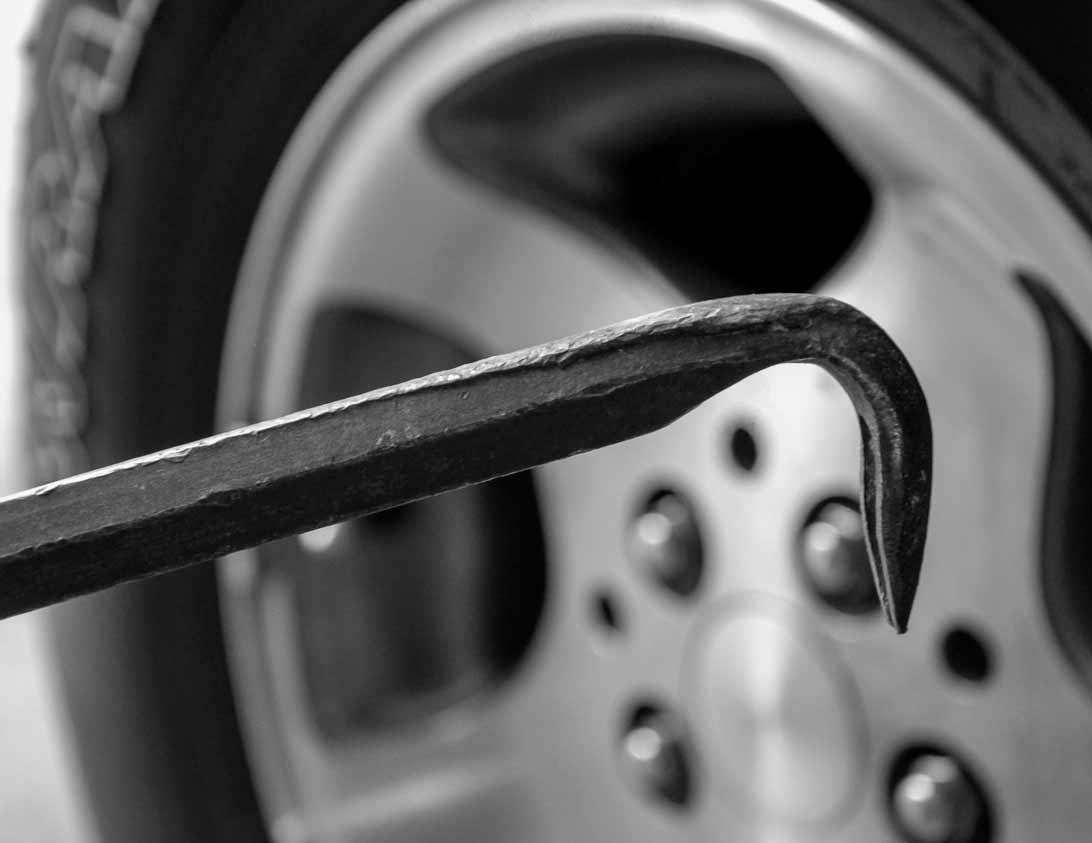 Let the glue dry for a minute.
Let the glue dry for a minute. The fencing must be carried out twice as carefully and more slowly than dismantling, lubricate the side with water or soap, “help” more with your hands, otherwise there is a risk of picking up the edge of the chamber with a spatula and tearing it.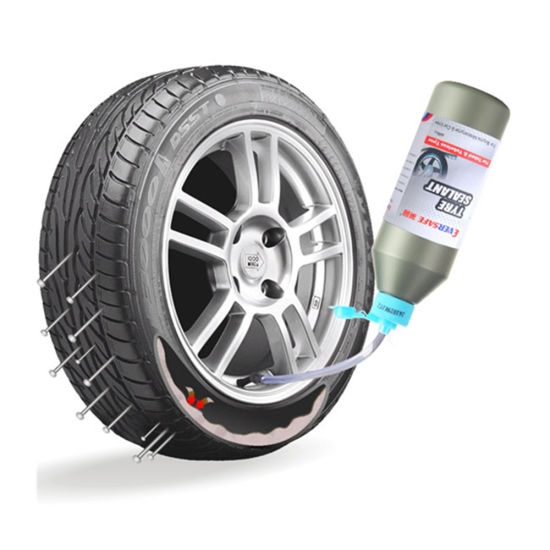
Important! If the wheels of the motorcycle are equipped with tow bars - before pressing the tire bead from the rim, you need to loosen this tow bar! But do not unscrew the nut completely, do not disassemble to the end.
A standard “first aid kit” (a set for repairing classic motor rubber) contains only patches and glue, so it is advisable to supplement it yourself with a piece of “skin” or a needle file. You can degrease with gasoline, or apply a little glue first and wipe off immediately, rolling up the dust with it.
Now there is no shortage of specialized motorcycle workshops not only in Moscow - in all major cities there are motorcycle helpers who help motorcyclists directly on the track, or tow to where you can quickly change the camera, or patch the tubeless correctly, so that there is no trace left. Where there is a guarantee.
Self-replacement of a tire on a motorcycle requires a certain physical condition, and for the first time - a “kilometer of nerves”.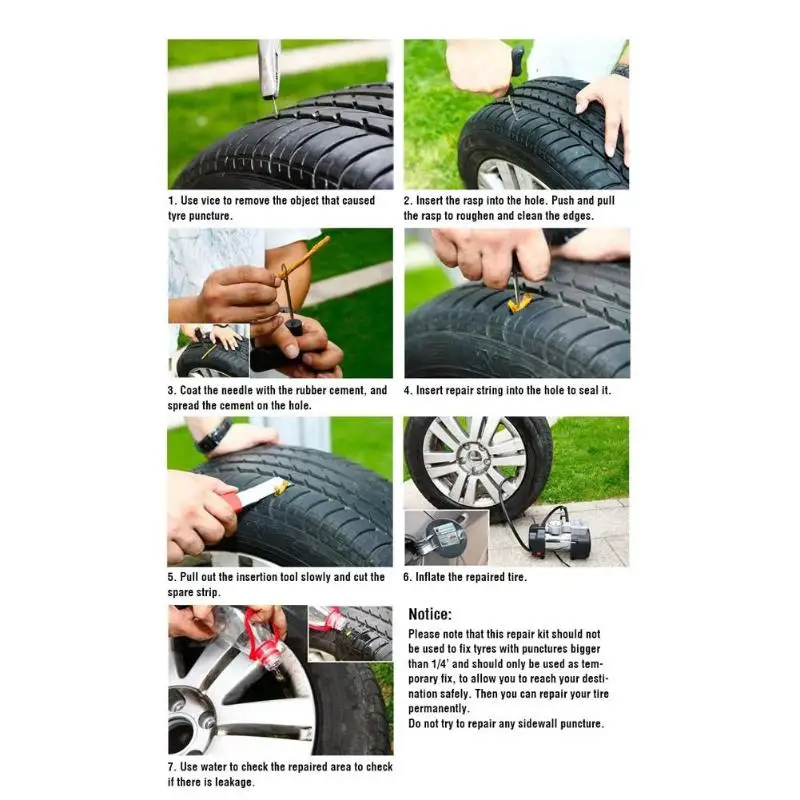 At the service station, instead of you, automation will “sweat”, which will not lock up the board and will not scratch the disc coating with a spatula. The main thing is to do it quickly (if you need to go urgently, the price sometimes does not matter).
At the service station, instead of you, automation will “sweat”, which will not lock up the board and will not scratch the disc coating with a spatula. The main thing is to do it quickly (if you need to go urgently, the price sometimes does not matter).
Repair at the service - may be the only possible one if, due to driving on a flat tire, the tire nipple is turned and torn off. Especially if he flew off and got lost, but there is no spare. In mototiremontazhke - there is always a set of consumables for any wheel diameter. In the same place, in extreme cases, you can buy a new tire, or a used dokatka.
In addition to the patch, for normal operation of the wheel, balancing must be ensured. This is generally a useful procedure during any change of rubber, otherwise if there is a strong imbalance, the wheel bearing will inevitably break due to vibrations, and the hands will quickly get tired and “buzz” after long rides.
The first couple of tens of kilometers - do not drive, go at the speed of the stream. Stop, check for a flat tire. If the patch is not of high quality, it will manifest itself almost immediately. Parking will tell about the long-term perspective: if the cylinder has not lost volume in the first day or two, then everything is in order, you can drive as before.
Stop, check for a flat tire. If the patch is not of high quality, it will manifest itself almost immediately. Parking will tell about the long-term perspective: if the cylinder has not lost volume in the first day or two, then everything is in order, you can drive as before.
Knowing what to do if a flat tire is on the road is important not only “for yourself”. To help a newbie or a fragile girl is to earn an important “plus in karma”, which will later return at the right moment. But, I hope, this knowledge will be useful to you only in theory. Good luck on the roads, no nail, no wand!
The motorcycle gives a feeling of freedom, allowing you to discover new routes. However, in reality, this freedom can turn into a trap in an instant if you are unlucky enough to puncture a tire somewhere in the middle of the road. The feeling of annoyance will be ten times stronger if there is no way to fix a punctured wheel. At this point, it remains only to hope for cellular communication and help from other drivers on the road.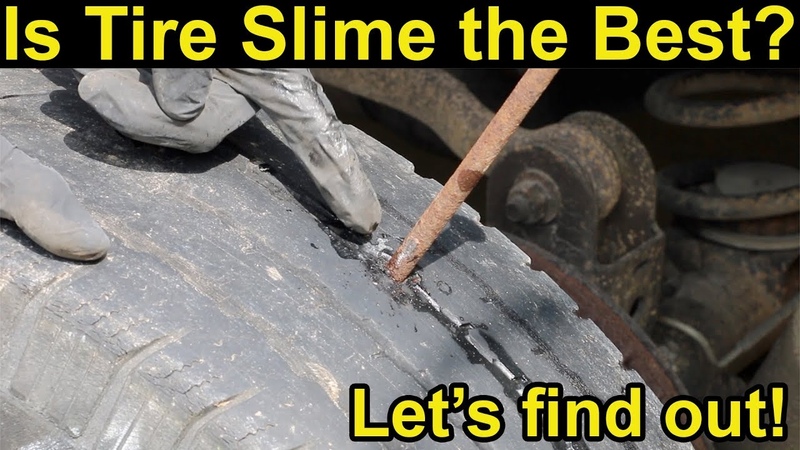 Therefore, consider the basic recommendations for repairing a motorcycle tire on the road.
Therefore, consider the basic recommendations for repairing a motorcycle tire on the road.
Always keep a rubber band or tire repair insert in the trunk. This simple tool will add peace of mind on the road. It will be much better if you learn how to use it in advance. You don't want to be the guy who has the right tool but lacks the skills to fix a problem, even something as simple as fixing a tire, do you?
The repair technology for tube and tubeless tires is different, but both types are subject to restoration (at least to such a state as to get home). Repairing a tubeless tire is easier. Repairing a tubed tire requires removing the wheel, removing the tire, and removing the tube to install the patch.
So you run over a nail, screw, glass, or that damned sharp stone and punctured a motorcycle tire. If the object that caused the damage is still in the rubber, the first step is to remove it. Pliers are great for this. Therefore, you should always keep this tool in the trunk: with it, you need to grab an object sticking out of the tire. Try to pull it out along the same path that it entered the tire so that the puncture does not increase and become torn.
Therefore, you should always keep this tool in the trunk: with it, you need to grab an object sticking out of the tire. Try to pull it out along the same path that it entered the tire so that the puncture does not increase and become torn.
After removing the object, clean the edges of the pierced hole. To do this, the repair kit must have a special tool - a tool for cleaning holes. All debris and rough edges must be removed to create a surface for patching.
Then you need to install a patch. Different kits offer different types of patches, so you should read the kit's manual to complete this step correctly. However, there are two main types of patches: long cord patches and fungus patches. Some kits may include adhesive to bond the patch to the tire rubber.
Patches or cord inserts are supplied with an awl for installation. It is necessary to bend the cord in half, and thread one half into the tool. This is necessary for a tight fit of the material.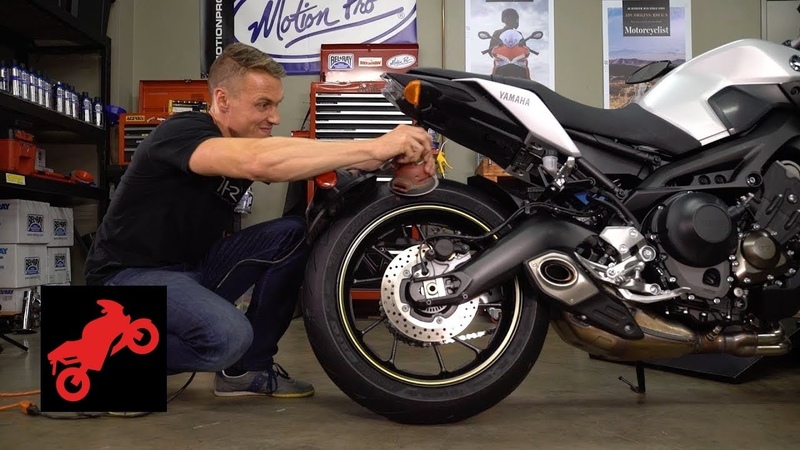 Next, bring the cord into the hole until it protrudes above the tire by about 1 centimeter. Then you can pull it out of the awl and put the tool aside. Take a knife and cut off the excess patch material by about 0.5 centimeter.
Next, bring the cord into the hole until it protrudes above the tire by about 1 centimeter. Then you can pull it out of the awl and put the tool aside. Take a knife and cut off the excess patch material by about 0.5 centimeter.
Fungus patches (plug and play type) require the use of a special tool for installation. Again, you must follow the instructions for the specific repair kit. Then stretch the patch material with pliers. When the puncture is closed, you can cut the patch over the tire.
After installing the patch, the tire needs to be inflated. For repairs on the road, you will need either a 12V electric compressor that can be connected to the motorcycle's electrical system, or a CO 2 tank. Carrying a compressor with you is not always convenient. A more compact and more portable option is to use the small cans of CO 2 in combination with the tire inflator. This is the fastest way to inflate tires on the road.
If possible, apply some soapy water to the patch to make sure it is airtight.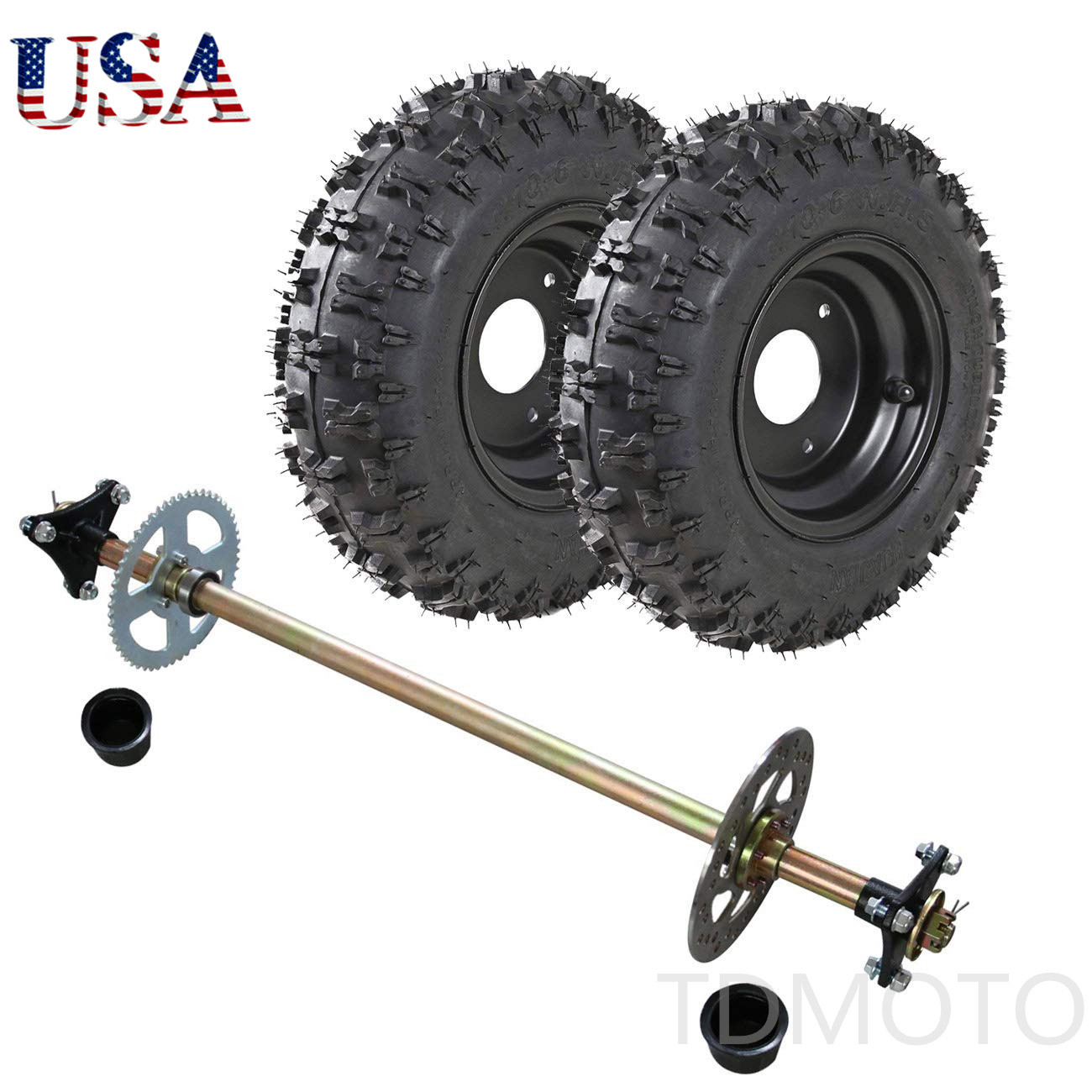 If there is a leak, you will see tiny air bubbles around the repaired area.
If there is a leak, you will see tiny air bubbles around the repaired area.
On-road retreading of tube tires is a more labor-intensive process. If your motorcycle is equipped with such tires, then you will need a few more tools to repair them. In most models, you will have to remove and disassemble the wheel in order to get to the camera. The vehicle owner's manual should describe how to do this and what tools to pack in your luggage. In addition, you will need a tire removal tool. It makes the job easier.
Once the inner tube has been removed from the wheel, the remaining air must be completely bled out. The next step is to prepare the camera for patching. The repair kit should include a special scraper to roughen the surface around the punctured hole. This treatment is necessary to ensure adhesion of the patch to the chamber material.
After completing the preparation, you can start installing the patch. Follow the instructions in the repair kit manual.